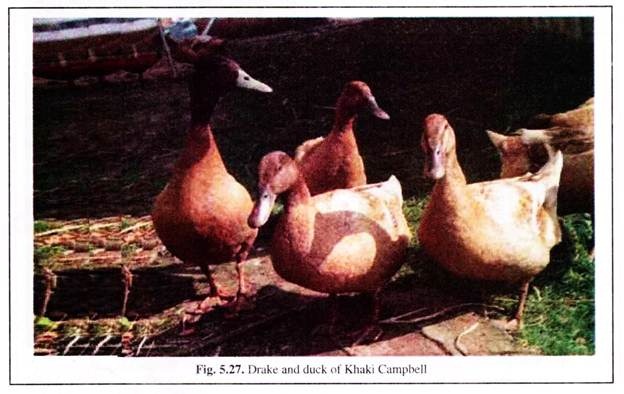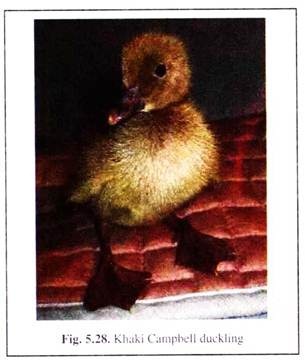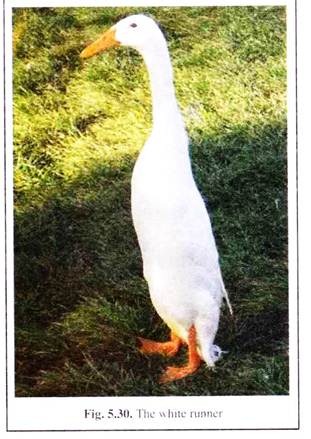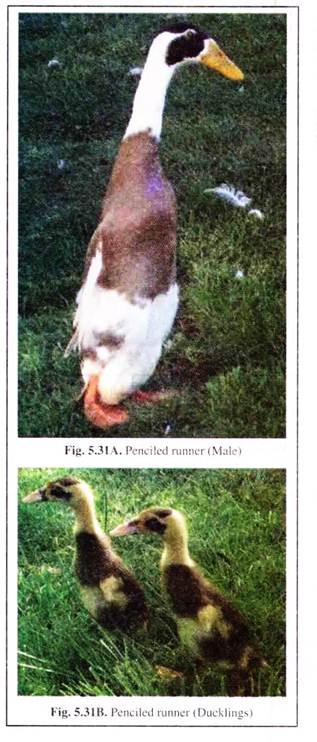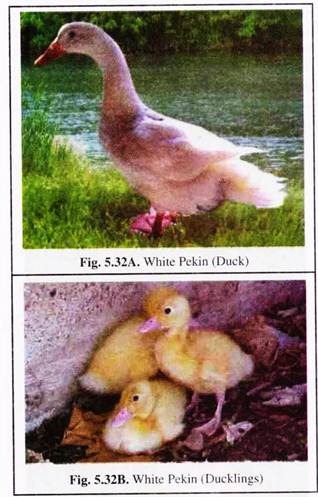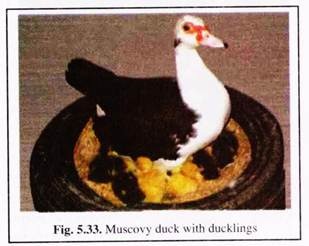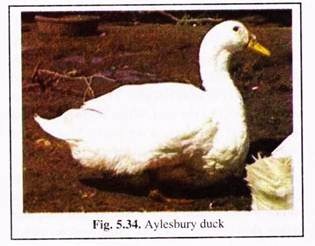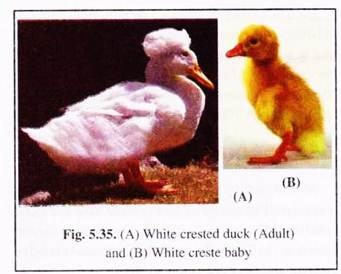Breeds of the duck can be classified into three main groups:
(A) Egg types consisting of Khaki Campbell and Indian Runner breeds.
(B) Meat type consisting of White Pekin, Muscovy and Aylesbury breeds.
(C) Ornamental type consisting of Crested White breed.
(A) Duck Reared for Egg Production:
These breeds are reared for production of eggs:
(1) Khaki Campbell:
The khaki Campbell breed (Figs. 5.27 and 5.28) has been developed in England from a cross of Fawn and White Runner with Mallard ducks. Ducks have brownish bronze lower part of back; tail coverts, head and necks rest on the body and plumage is khaki.
They have green bills and dark orange legs and toes. The adult drake weighs between 2.2 to 2.4 kg, while the duck weighs between 2.0 to 2.2 kg and that of an egg is about 70 gm. Egg production average per duck is close to 300 eggs per year.
(2) Indian Runner:
There are three standard varieties of this breed, namely the Fawn, the White Runner and the Penciled variety.
Indian Runner is a good layer having an average record of 250 eggs per year:
(a) The Fawn:
ADVERTISEMENTS:
They are white with fawn coloured back and shoulders (Fig. 5.29). The upper part of its breast and wings are fawn coloured, while the lower part is white. Body is long and narrow, slopping gradually into the neck and resembling somewhat a penguin in shape.
The shanks and toes are orange red. The bill of the young drake is yellow, later becoming greenish yellow while a young duck has a yellow bill spotted with green, which later becomes a dull green.
(b) The White Runner:
This variety is pure white in colour all throughout the body (Fig. 5.30). The bill is yellow and the shanks and toes are orange coloured.
(c) The Penciled Variety:
The head of the male is dull bronze-green and white in colour. The back has a soft, fawn ground, finely stippled with a slightly darker shade of fawn (Fig. 5.31 A&B). The body and the upper section of the breast are medium fawn and the tail of the female is medium fawn and white in colour.
In female a white marking in the plumage resembles those of the male. The coloured markings are a medium fawn throughout, with a light line of fawn colour running around the edge of each feather, the border being a darker shade.
(B) Duck Reared for Meat Production:
Duck meat is highly acceptable among the non- vegetarians. Though not popular due to non-availability in the market. The meat is rich in fat (14.5%) and total energy (190 kcal/100 gm). The protein content averages about 13 per cent. White Pekin is the most popular meat type duck in the world.
Some of the meat type ducks are described here:
1. White Pekin:
This breed originated in China. Birds are large white-feathered. They have orange- yellow bills, reddish yellow shanks and feet, and yellow skin (Fig. 5.32 A&B). Their eggs are tinted white in colour and its production is considered less important than its capability to produce excellent quality meat. Birds of this breed are bad sitters and very sensitive to outside interferences. Hence they should be treated gently.
2. Muscovy:
It is very much questionable whether Muscovy is really a duck or not (Fig. 5.33). It is more like a goose in many ways than one; for instance, it is a grazer and eats grasses in the same way as a goose. They are very strong and powerful in flight, yet very tame and friendly.
The ducklings are late in feather formation by four weeks; it takes about 16 weeks, whereas in other breeds the ducklings are in full feather at 12 weeks. The drakes are big in size and weigh above 4.5 kg, whereas ducks weigh about 3.0 kg. The breed is native to Brazil and very popular in Australia. When crossed with other breeds, it produces sterile ducks, known as mule ducks which produce higher meat yield.
There are two varieties of Muscovy ducks, the white and the dark. The head and face of the Muscovy are partly bare, with red, rough skin. It has a long, broad body, with greater breadth. The white variety has pure white plumage, pale orange or yellow legs and a pinkish, flesh-coloured beak.
The dark variety has got a lustrous blue-black body and back. Both the varieties provide meat of excellent quality and taste, if marketed before 17 weeks of age. They are also good sitters and will hatch and care for approximately 30 ducklings in one batch. They produce 40-45 eggs, annually. Muscovy male has no curl feathers in his tail. Ducklings emerge from eggs after 36 days of incubation period.
3. Aylesbury:
This breed originated in Buckingham in U.K. The plumages are white; legs are short but sturdy and orange in colour (Fig. 5.34). Due to its light bone and high percentage of creamy white flesh, the breed is regarded as a delicious table bird. It reaches market weight in 2 weeks. Eggs are tinted white in colour.
4. Broiler Duck:
Another short broiler type of duck, found in Kalluru lake area of Andhra Pradesh is famous for meat production. They are similar to broiler chicken and are marketed at the age of 6-8 months. The meat of such ducks is said to be tasty and nutritive.
(C) Ornamental Type Duck:
Crested White Breed (Fig. 5.35 A&B):
This variety is very popular for duck lovers in European and American countries. They are beautiful looking and delicate. Adults are with rosy crest. They have very low economic value but have recreational importance.
